Another Crab’s Treasure is an action RPG that follows the treasure hunting adventures of crabs who live in the polluted shallows and reefs of the coastal ocean. I play as Kril, a young hermit crab whose large and sturdy shell is repossessed by a suspicious loan shark. Kril’s attempts to reclaim his shell bring him to the trash city of New Carcinia where he makes a deal with the local prawn broker: Solve the recently discovered treasure map which has excited New Carcinia’s populace and deliver its reward, and Kril can buy back his shell. Arming himself with a rusty fork and wearing any detritus he can find to protect his vulnerable tail, Kril’s quest takes him across a variety of coastal environments. His quest is deadly as everywhere he searches for the treasure, he encounters hordes of sealife driven into an aimless madness by the Gunk which emanates from the trash polluting the ocean floor.

Normally I disdain directly comparing one videogame to another in a review unless I have an excellent reason to do so. Since Another Crab’s Treasure describes itself with the portmanteau “Soulslike” twice in less than one hundred words on its official press factsheet, I not only feel the comparison to FromSoftware’s infamous Dark Souls series is justified for this review, it is unavoidable.
Another Crab’s Treasure asks to be compared to Dark Souls, and so I shall oblige.
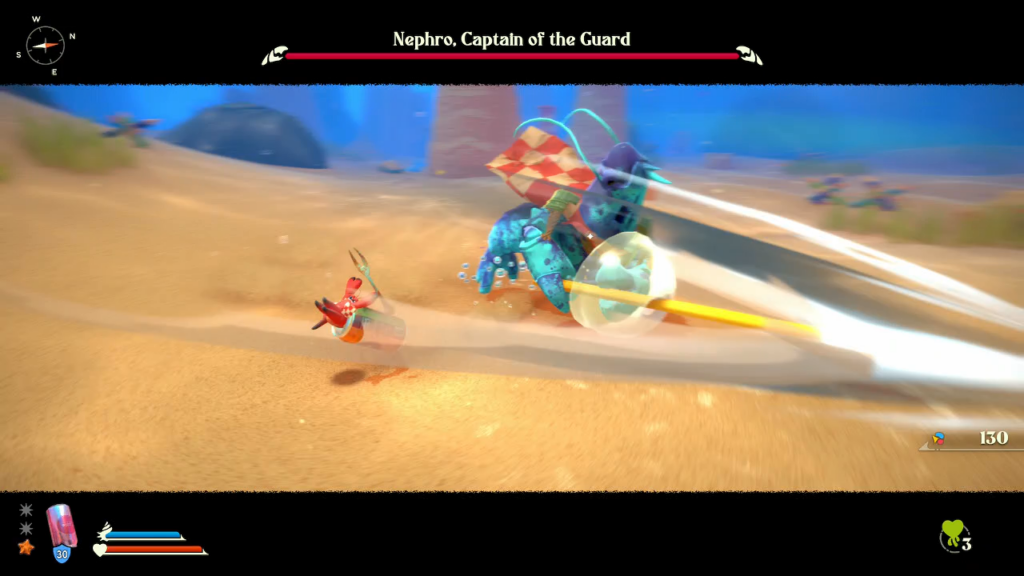
Having prior experience with the Dark Souls videogames, I am immediately comfortable guiding Kril in combat. The iconic Soulslike combat flow is replicated here. Kril may only take a few hits from the ocean’s crazed fish and crustaceans before dying and swings from his fork-weapon are slow. I leave him vulnerable with every press of the attack button. Enemies from the smallest seahorse to the largest spider crab must be approached carefully and methodically, their attacks deflected or dodged, and then counterattacked during the small moments when they leave themselves exposed. Reckless and repeated attacks are often an invitation to a quick death. Kril’s most difficult opponents are not necessarily the strongest but rather those with the most intricate attack animations and briefest opportunities when they drop their guard.
Another Crab’s Treasure consciously differentiates itself from Dark Souls with a lack of a stamina meter. Kril may indulge in relentless aggression, swinging his fork over and over again until either his target dies or he takes one too many blows and succumbs himself.
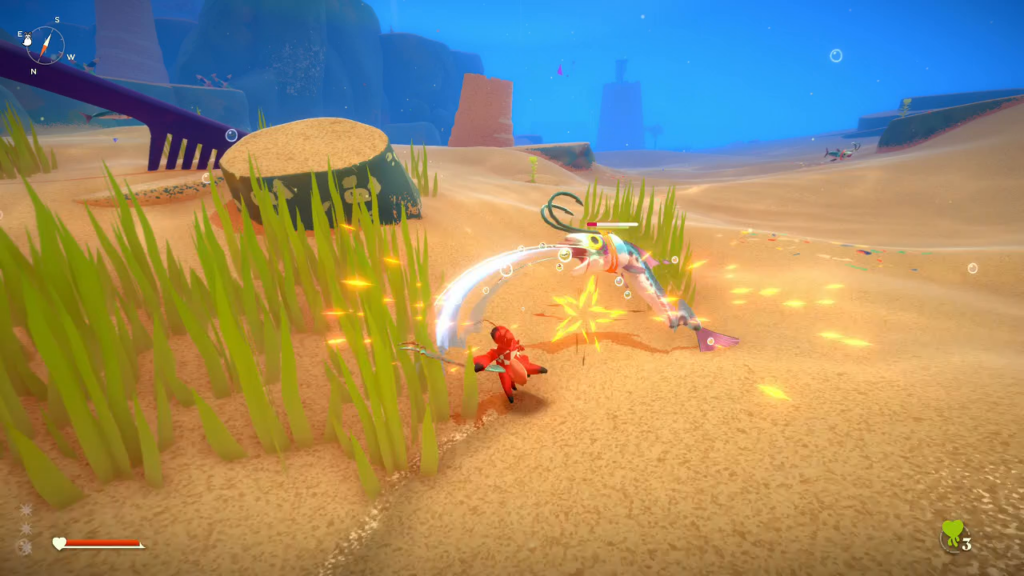
I worry that Kril’s bottomless stamina reserves will cause players inexperienced with Soulslike combat to have difficulty engaging with its familiar flow. No stamina means there is one less system to comprehend and balance, making Another Crab’s Treasure slightly more approachable to new players who may be intimidated by the many numbers on a traditional Dark Souls character sheet. Fewer systems aren’t always an improvement; an emptied stamina meter creates organic moments where the player character is forced to catch their breath before swinging their weapon, reinforcing the underlying give-and-take of Soulslike combat design. Another Crab’s Treasure replicates that design philosophy but lacks those organic moments which communicate it. Instead the lesson is a crab smashing a claw or heavy object into Kril’s face until he dies. I worry a player new to Soulslike combat may draw from this experience not that they need a new approach but that Another Crab’s Treasure is too hard to be fun.
Healing the damage the player character inevitably takes in combat is also a spin on a familiar Soulslike mechanic. Kril carries with him a clawful of nutritious plants called heartkelp bulbs which recover his health when eaten. They take a moment to eat, preventing him from healing when he is under sustained attack, but consuming one restores a large portion of his life bar. Unlike Dark Souls’ healing Estus Flask, which can normally only be replenished at bonfire checkpoints, heartkelp bulbs grow nearly everywhere on the ocean floor and are also common drops from enemies. Kril almost never runs out except in the most difficult combat encounters and the next enemy he kills will almost surely drop one if he does exhaust his supply.
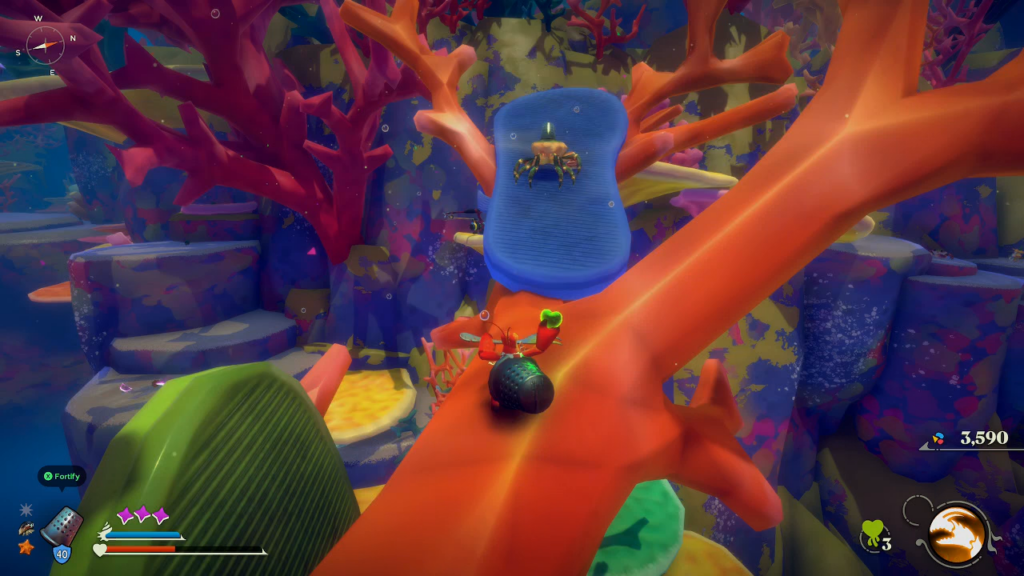
Where Another Crab’s Treasure really finds its own identity outside of Dark Souls is with shells. Instead of bearing a shield, Kril hides his vulnerable spiral tail inside makeshift shells he finds strewn across the ocean floor. When I hold a button, Kril crams his entire body into his current shell and can even continue moving around at a waddling pace. While he hides, Kril’s shell prevents damage to his fragile carapace until it fractures under the weight of enemy attacks.
Shells come in dozens of variations. Most are not actually shells, they are pieces of garbage which have sunk to the ocean floor. The first shell Kril finds is an empty soda can found beside a submerged vending machine. These soon give way to bottle caps and tin cans, and then more unusual objects like party hats, thimbles, and disembodied dolls’ heads.
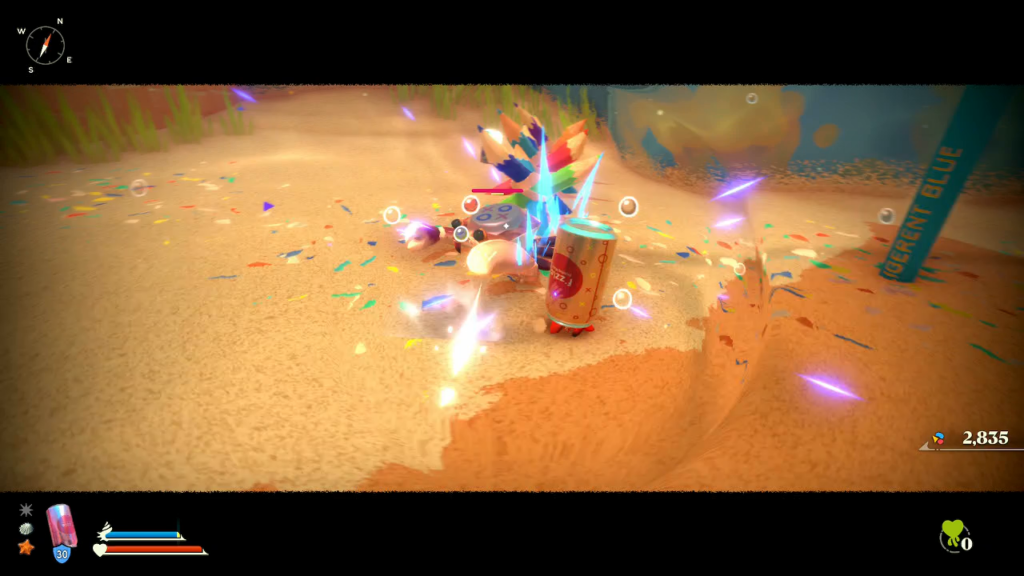
The shell Kril wears affects his physical capabilities. A larger shell might have increased durability, letting it absorb more enemy attacks before it breaks, but its greater weight shortens the distance Kril is carried by his dodge ability, making it more difficult to avoid enemy attacks. This becomes a problem when he faces an enemy with attacks which must be dodged no matter the sturdiness of his current shell. Kril might feel safer with his tail secure inside a coconut or ham tin but when guided by a skilled player, a lighter shell provides similar defensive advantages without sacrificing his agility.
Early in his adventure, Kril is taught how to channel a magical power called Umami that expresses itself in a variety of useful ways. He can unleash specialized offensive skills called Augmentations he learns by defeating powerful, and sometimes hidden, bosses. Crystallized Umami is found hidden throughout the ocean floor and even absorbed from some of the crazed creatures that live there who release it upon their death. When gathered, Kril can exchange this resource for upgrades to his attacks and defenses, like allowing attacks from his fork to regenerate the damage his shell has taken or to deal a devastating critical hit to enemies which have been toppled onto their backs.
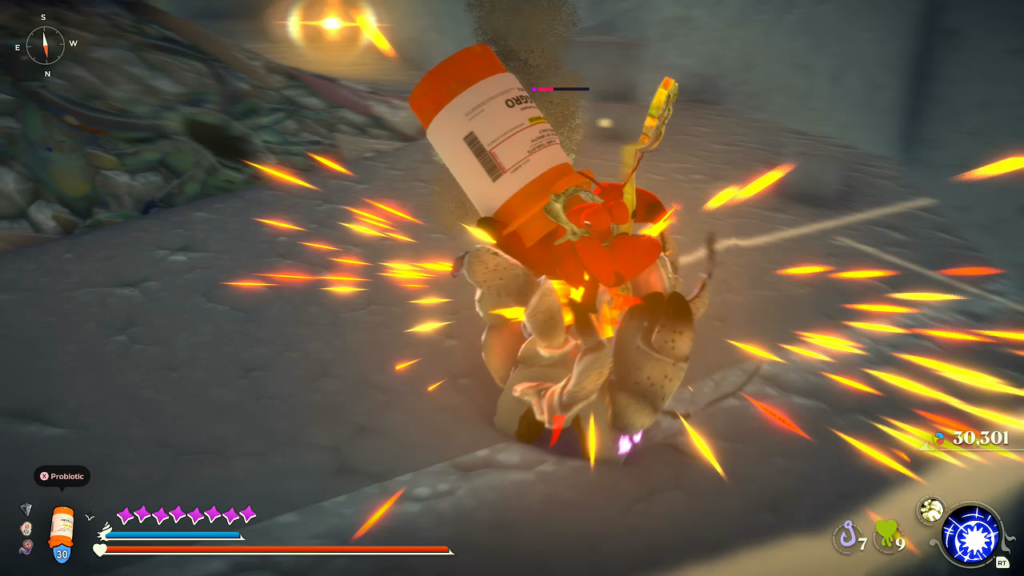
Umami’s most impactful and regular use are the unique abilities Kril can express from the shells he wears. Almost every shell has a unique Umami ability. Tin cans allow Kril to use Shellshock, imbuing his shell with electrified energy which damages enemies when their attacks impact it. Coffee pods come with the Morning Buzz ability which increases the speed of Kril’s attacks. The Probiotic ability attached to yogurt containers is the most overpowered of all, conferring rapid health regeneration upon Kril. If this indispensable advantage is meant to be offset by the shell’s comparatively lower durability and defense, I barely feel the penalty. Probiotic essentially renders heartkelp bulbs redundant and a shell’s Umami powers are refreshed with every attack Kril lands, so a Yoccult yogurt container essentially provides infinite healing. I ensure Kril is proudly ensconced in one whenever possible.
When improving the player character’s statistics, Another Crab’s Treasure returns to closely aping Dark Souls conventions. Kril absorbs a resource from the bodies of every enemy he defeats: microplastics. Kril carries these tiny fragments in his body wherever he goes. If he dies, he drops his current microplastics and returns to the previous save point. If he can return to where he died and touch his corpse, he reclaims those microplastics. If he dies before reclaiming them, those microplastics are gone forever. These systems will be familiar to Dark Souls veterans and even to players of many other RPGs which have borrowed and normalized them.
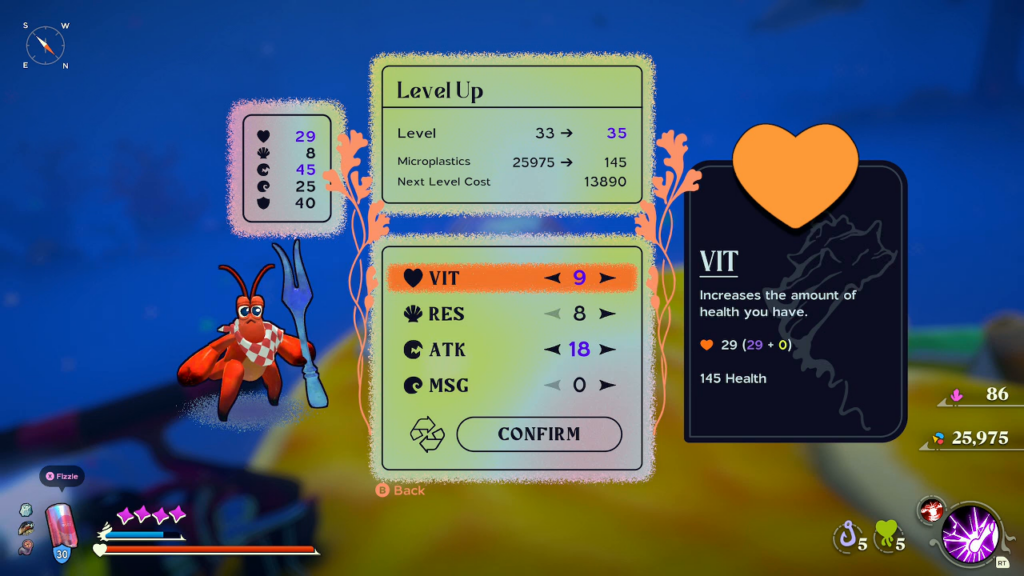
If Kril can make it to a save point with a stash of microplastics, he may improve one of his statistics by symbolically purifying his body of them. Statistics are kept as simple as possible. Vitality increases his health. Resistance improves the durability of Kril’s shells. Attack improves the damage Kril deals with his fork. MSG improves the effectiveness of Kril’s Umami skills. Thanks to this simplicity, choosing which stats to improve is straightforward. If Kril feels weak, boost his Attack. If enemy attacks are too damaging, improve his Vitality. If Kril’s shells break too quickly, improve his Resistance. Only MSG feels useless. I never invest a single point in it and all of Kril’s Umami skills still feel powerful and useful.
I manage to fight Kril’s way through his adventure without too much difficulty, aided significantly by my prior experience with the Dark Souls videogames it borrows so many ideas from. Bosses are the most fearsome and troublesome enemies but Another Crab’s Treasure defies the Soulslike tradition of forcing me to run from distant save points to challenge them again upon Kril’s death. Every boss is signposted by a checkpoint found just outside their arena’s perimeter. If Kril dies in combat, he returns to that checkpoint with a fresh shell, ready to fight again. My time is never wasted on aggravating runs back to a boss’ room. I can challenge them again within seconds, keeping me focused on learning boss mechanics and not on tedious routes from previous save points.
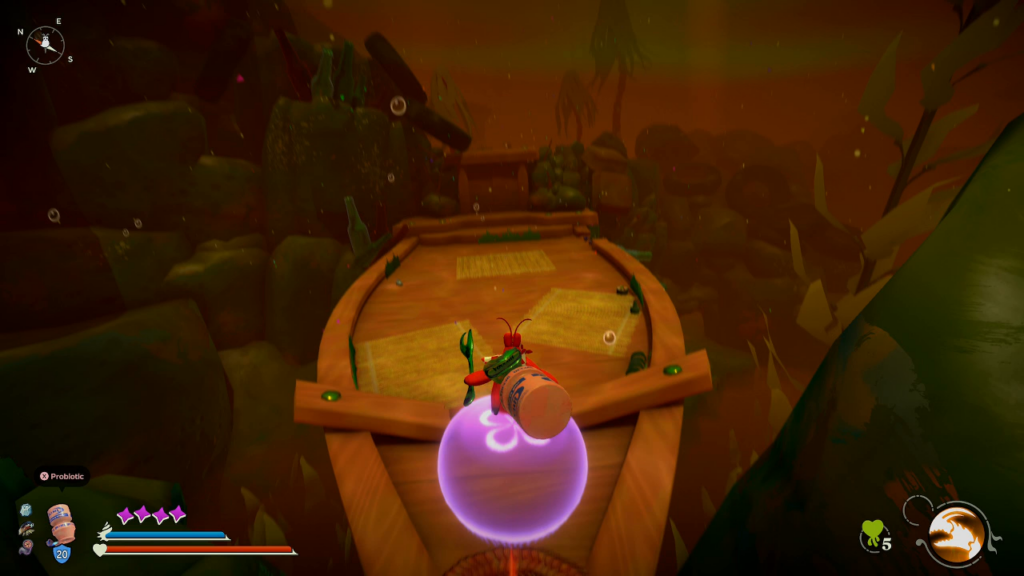
If I didn’t have prior experience with Dark Souls, Another Crab’s Treasure wouldn’t want me to be left out of the fun. It offers a number of Assists which may be turned on and off at any time. Most give generous combat advantages to Kril. I can individually give his shells extra durability, reduce the damage he takes, and lower enemy health totals. More granular toggles increase the number of invincibility frames hidden in Kril’s dodge or even outright slow the speed of the entire videogame down.
I’m not sure Assist Mode will give every player a fighting chance against Another Crab’s Treasure’s Soulslike combat. It definitely makes an admirable attempt to be more inclusive than the stereotypical response of a sneer and a “git gud” meme. It’s even refreshingly nonjudgmental about Assist Mode being used; there are no taunting or condescending messages when assists are activated, they do not force the videogame to end before the final boss, and they do not disable earning achievements. If every other assist toggle fails me, the final one gives Kril a gun he can use to kill everything he encounters in a single shot, including the final boss. I’m not thrilled that Another Crab’s Treasure’s ultimate remedy for the tedious Dark Souls difficulty debate is gun violence but I appreciate the effort.
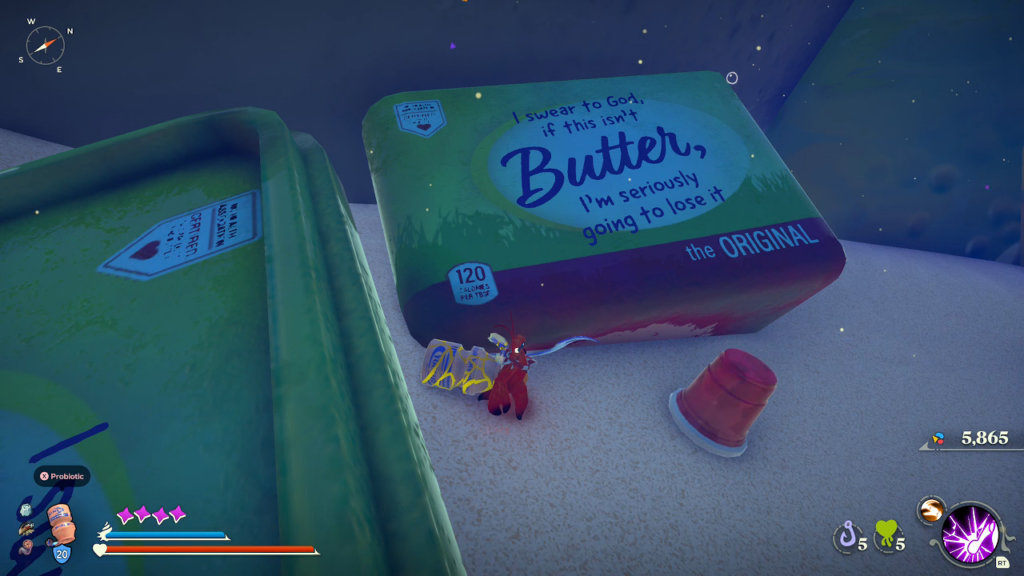
The world that Kril explores in between all of this fighting and dying is a beautiful coastal wonderland buried in disgusting trash. Around almost every corner, Kril finds the consequences of humanity’s industrial ingenuity. Metal scraps and plastic containers lie half-buried in the sand, creating interesting playgrounds full of secrets and dangers for Kril to explore. Then he gets close to the plastic containers and I see they’re inscribed with parody brands like “Shucker’s Uncrustworthys” and “I Swear To God, If This Isn’t Butter, I’m Seriously Going To Lose It.” These gags squash the horrific implications of the trash; I’m too busy laughing to feel bad about my complicity in ocean pollution. This bathetic contrast keeps Another Crab’s Treasure lighthearted even as it portrays serious issues.
Trash features in character designs as well. Konche, a knowledgeable elder hermit crab who serves as Kril’s guide, uses a dental floss pick as a cane. Mighty lobsters called Shellsplitters wear trash bags on their heads that resemble an executioner’s hood and carry heavy U-style bike locks modified with sliding blades they wield both as massive clubs and portable guillotines. Recurring ranged enemies are sea horses who spit tiny orbs that violently expand in an instant, potentially pushing Kril off of cliffs. It takes me a few hours to notice they are spitting dinosaur-shaped sponge capsules and even store their projectiles in water-tight breath mint containers. The imagination put into taking common objects humans would carelessly discard and turn them into deadly weapons is impressive.
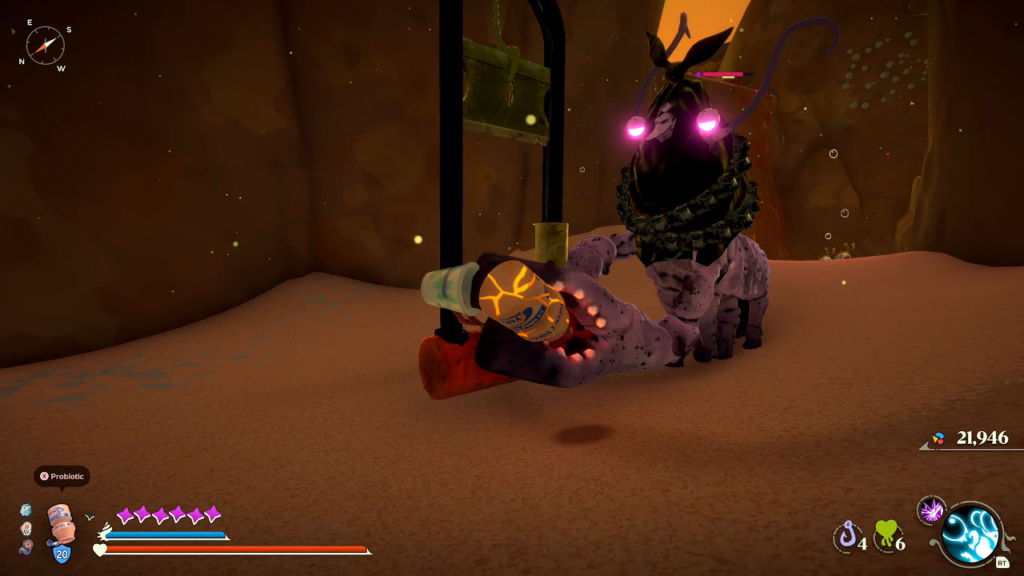
I wish that I could immediately feel that same imagination put into Another Crab’s Treasure’s level design. Early areas like The Shallows and The Sands Between are largely flat and featureless, making them difficult to explore. The draw distance, which is surprisingly limited even on powerful platforms, can make Kril feel like he is standing in a vast desert with nothing around him. Umami crystals and other collectables found in these spaces don’t feel hidden so much as dropped randomly and discovered through serendipitous wandering.
These early spaces give way to more intricate ones later on. Kril’s search for the treasure takes him through a kelp jungle, a garbage dump, and to the ocean’s darkest and most terrifyingly unfathomable places. These areas are filled with diverging routes, precarious paths perched high above areas Kril visited hours before, and the trademark Dark Souls shortcuts where opening a locked door or pressing a button makes a return trip much faster and less dangerous. Seeing the growth in level design intricacy from the vast, barren early areas to the dense and focused later ones is like experiencing their developers grow in skill and confidence from novices into masters in real time. The ultimate area leading up to the final boss could proudly link itself to any official Dark Souls world and not seem out of place.
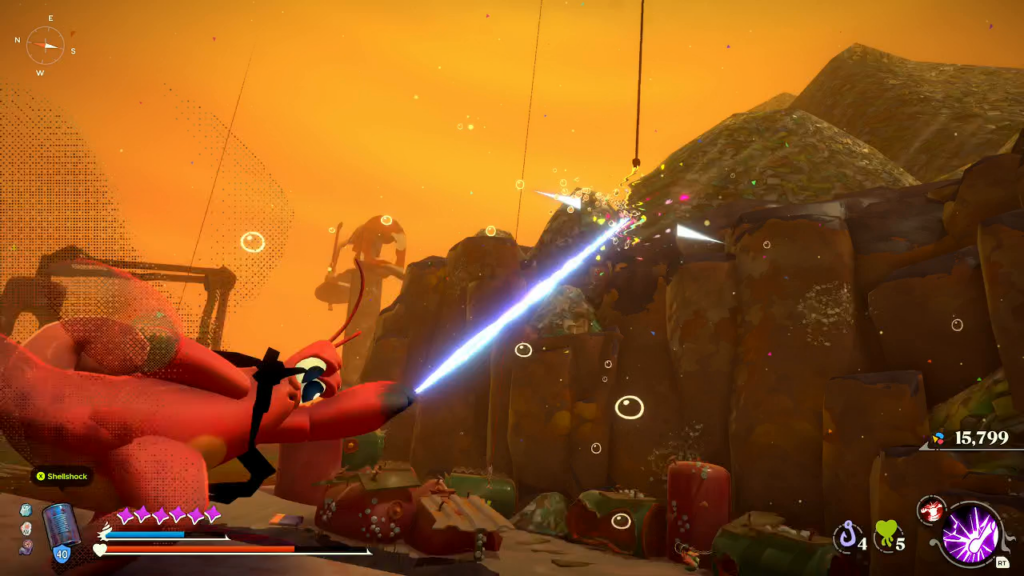
Much of this intricacy is created by Kril’s most useful movement ability. Early in his quest he is given a fishing line and a hook he can connect to targets around the world, pulling himself towards them with surprising strength and speed. Most of these targets are connected to scraps of fishing net that Kril can climb along to new areas and previously unreachable platforms. Since Kril explores mostly underwater areas, he can also cause his jumps to travel slightly further by pumping his arms. These abilities make Another Crab’s Treasure feel more like a 3D platformer, adding a new and much welcome dimension to traditional Soulslike exploration.
While it adheres to and diverges from Soulslike design conventions in several notable ways, thematically Another Crab’s Treasure’s playful tone and barrage of crab puns ultimately makes it feel more like a parody of Dark Souls than a wannabe like Mortal Shell or Hellpoint. This doesn’t mean that it doesn’t have something to say. When it wants to criticize something it doesn’t make any effort to pull its punches.
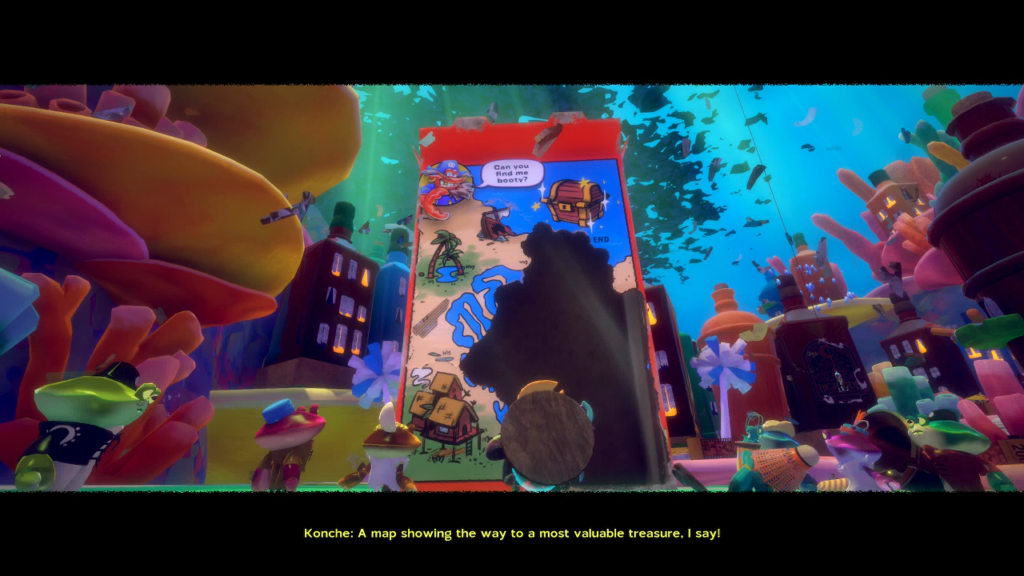
The main target of ire is obviously humanity and its impact on the environment. Despite using our trash to build the city of New Carcinia and adapting it into weapons, armor, and decoration, the crabs of the ocean floor have no concept of humanity. Our species is not directly acknowledged by the characters in any way. Only our impact on their world is felt. A floating mass of trash, similar to the Great Pacific Garbage Patch, regularly drops fresh refuse onto New Carcinia. These showers seem like divine gifts from an unknowable force living high above. To some crabs, they are opportunities for new riches—including the treasure map that really kicks off Kril’s adventure. To others, it delivers Gunk to their home, the substance that infects crabs and other sealife, transforming them into the berserkers that menace Kril and his fellow treasure hunters.
Our discarded objects trouble the crabs with more than new, potentially dangerous objects and the transformative Gunk. It also injects some of humanity’s most toxic ideas, like capitalism. One of the story’s primary antagonists is Roland, a horseshoe crab who has turned the recovery and exploitation of trash into a monopolistic enterprise he maintains with murderous domination. His endless lust to own even more trash drives much of the conflict as he carelessly spreads the Gunk around the ocean floor, turning much of his own workforce into zombies.
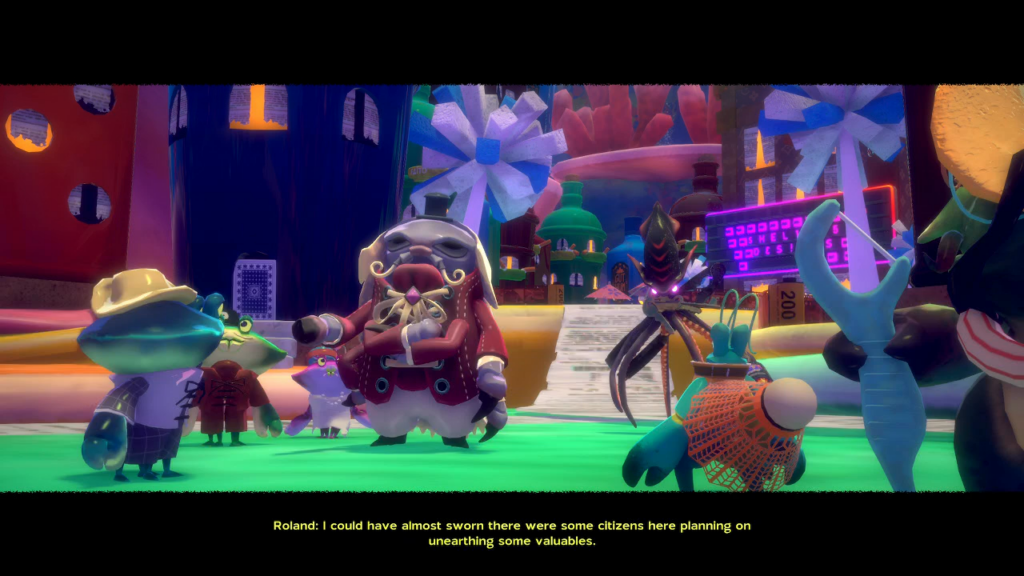
Roland is simultaneously reviled and worshiped by the inhabitants of New Carcinia. Many of them rightly see him as a destructive villain but feel helpless to defy him because of his wealth and accumulated power. Other characters are more ambivalent. Firth, another hermit crab searching for the treasure, idolizes Roland and refuses to believe any of the problems he causes are deliberate. Much of Firth’s dialog echoes the grindset ethos of people who worship the likes of Jeff Bezos, Elon Musk, and others, billionaires who obtained their wealth through privilege and happenstance but portray their success as a result of effort and acumen. No matter how hard Firth works, he will never become as wealthy as his idol because the capitalist system on which Roland stands astride will not allow it. Firth’s tragedy is he will never realize that.
As detestable as characters like Roland and Firth are, no character is criticized harder by Another Crab’s Treasure than Kril himself. His situation is obliquely compared to homeowners who ignore or disclaim societal problems until those problems encroach on their property lines and force them to fearfully enter civilization. Kril’s only wish is to recover his shell and return to his tide pool, a place where he unhappily admits he does nothing all day. The latter parts of the story challenge his belief that he should return to that life where he was safe and comfortable, but also isolated and lonely. The new life he is thrust into may be filled with difficulty and anger and filth, but he is finally engaged with his community and fighting for a better future for himself and others. I didn’t expect the silly Dark Souls parody about crabs to have at its center a plea for suburbia to rejoin the world and yet, to my astonishment, there it is.
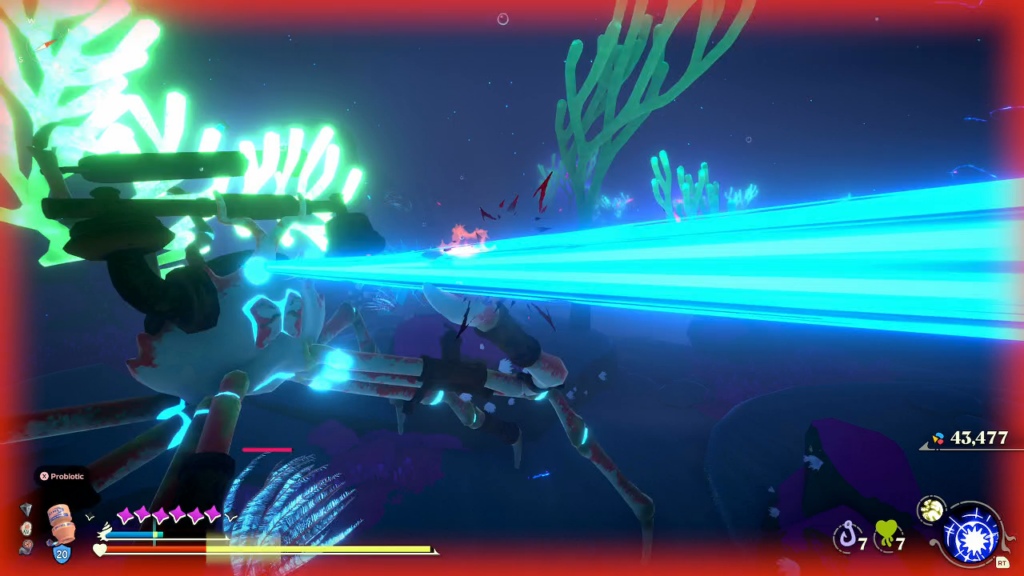
When I play other Soulslike videogames, I cannot forget that they are imitations of the Dark Souls series no matter how much I enjoy them. Another Crab’s Treasure transcends its peers. In its incisive characterization, accusatory themes, and vertical exploration that often feels like 3D platforming, it is superior to the Dark Souls videogames. Its combat isn’t always as good as the best Soulslikes, but it’s never as poor as the worst. Another Crab’s Treasure does itself a disservice casting itself primarily as a copycat. It is not only the best of the Soulslike imitators, it’s fun and interesting on its own merits. It earns one of my most sincere and emphatic recommendations.